Intro
On this day in November 1095, despite the cold and the snow falling on the mountain surrounding Clermont, capital of Auvergne, a large crowd had gathered for the arrival of Pope Urban II. When he spoke from the top of a simple wooden platform, there was a great silence. Everyone guessed that the pope was going to talk about the news that had spread throughout Europe about the Holy Land. And this news was disastrous for Christendom.
The issues
The pope's call
Urbain addressed the crowd in French:“O people of the Franks! People loved and chosen by God! From Jerusalem and Constantinople spread the grave news that an accursed race, totally foreign to God, has invaded the Christian lands, depopulating them with iron and fire. The invaders have taken prisoners:they take some of them as slaves on their lands, the others are put to death after cruel tortures. They destroyed the altars after having desecrated them. Stop hating yourself! Put an end to your quarrels Take the road to the Holy Sepulchre, snatch this land from an evil race, submit it! Jerusalem is a fertile land, a paradise of delights. This royal city, at the center of the earth, implores you to come to its aid. Go quickly, and you will obtain forgiveness for your faults! Also remember that for this you will receive honors and eternal glory in the kingdom of heaven. » A shudder, murmurs, muffled cries of indignation ran through the crowd. A famous monk preacher who participated in the Council of Clermont, Pierre d'Amiens, known as Peter the Hermit, cried out:“God wills it! » . The crowd echoed him like a rumble of thunder:"God wills it!" ". Thus began the First Crusade.
The Council of Clermont
The presence of the French Pope Urban II at the Council of Clermont attracted such a crowd that the meeting had to be held in the open air (unlike the miniature opposite), in a square surrounded by the tents of the participants, who had come from several countries.
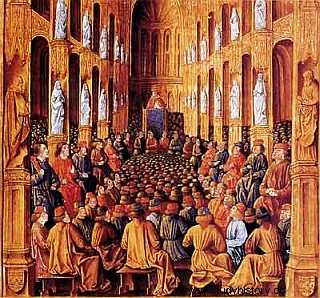
Book of Overseas Passages, 15th century, BN, MS Fr. 5594, f. 9
The Holy Land in the hands of the infidels
Urban II, monk of Cluny, continued in his own way the Gregorian reform of the Church initiated by his predecessor Gregory VII. The call of Clermont is part of the continuity of the "truces of God", the clergy invites the knights to interrupt their fights and to respect the non-combatants (women, children, ecclesiastics, merchants,...). In particular, the pope wants to moralize chivalry, eradicate violence and put an end to private wars between feudal lords. Now the crusades were to represent the most important and bloodiest military undertakings in medieval history. At the origin of this offensive of Christianity against Islam, there are very diverse causes and pretexts. In the Islamic world, important changes had taken place. The Arabs, civilized and tolerant, had always welcomed Christian pilgrims to the Holy Land without difficulty, and even more readily merchants from the West. However, their power in Palestine had been reduced by the advance of the Seljuk Turks. These Muslims were much harsher and more intolerant than their Arab co-religionists. In the 11th century, they occupied Mesopotamia, Syria, the ports of the Levant and Palestine with all its holy places, Bethlehem, Nazareth, Jerusalem. It was above all the occupation of the holy city that revolted the West, because it housed the Holy Sepulchre, housing the tomb of Christ. Even if, later on, the facts were exaggerated, it is true that the pilgrims of Palestine were the target of the persecution of the Turks. The desire to snatch these regions from the hands of the "infidels" was a powerful religious stimulus, which pushed many faithful to put on the white tunic "crossed", that is to say marked with the red cross of Christ. The determination of the Crusaders was reinforced by the first successes of the Spanish Christians in their enterprise of reconquest (Reconquista) of the Iberian Peninsula.
A praying crusader
Free from all ties, the poor respond to the call of the crusade with more fervor than the other social classes. Sensitive to the promised heavenly rewards, they sew a fabric cross on their clothes, hence their name of "crusaders" which will be attributed to them.
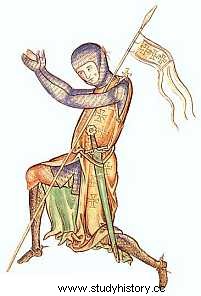
13th century, BL MS Royal 2A XXII f. 220
Political and economic reasons
The advance of the Turks directly threatened the Byzantine Empire which, for seven centuries, had constituted the rampart against which the Islamic expansion to the east of the European continent had been broken. In the aims of certain Western sovereigns, the crusades were to make it possible to come to the aid of the Byzantines, but also to establish, on their own account, “Latin” or Catholic enclaves in the Holy Land. This objective was supported in particular by the Italian maritime republics:the Turks, in fact, had cut off the routes of great trade with the East. Ports and counters under Christian domination would make it possible to reopen these roads, for the great profit of the Genoese or Venetian traders. The project of expeditions to the East also excited the imagination of hundreds of knights and barons penniless and without fiefdoms, cadets or simple adventurers who hoped to conquer far away lands and riches which they had not been able to find in the West. . Moreover, the blessing of the Church and the approval of Christendom crowned them with great prestige.
General enthusiasm
Enthusiasm for the crusade was enormous:tens of thousands of people, including women, old people, children, declared themselves ready to leave to liberate the Holy Sepulchre. There is no doubt that religious fervor was the main driving force behind this immense momentum. But other factors also fueled this enthusiasm. The pope released servants and vassals from their oath of loyalty to their lords throughout the period of the crusade. It was a godsend for hundreds of petty vassals, but even more so for thousands of peasants and serfs, for whom the crusade was the unexpected opportunity to leave their condition and become rich. Plenary indulgence, that is, forgiveness of all the sins they had committed, was additionally granted to the Crusaders. Moreover, these could not be judged, if they committed any crime, except by ecclesiastical tribunals, which were disposed to close their eyes to faults committed for the sacred cause. The appeal of the pope fell at the right time, indeed, since the year 1000, Christianity saw a revival:the warriors codified their fights and the peasants, benefiting from better security, improved their living conditions. The population began to grow rapidly, and Europe experienced a real economic boom. The world left the Dark Ages to enter the Late Middle Ages.
Peter the Hermit haranguing the Crusader troops
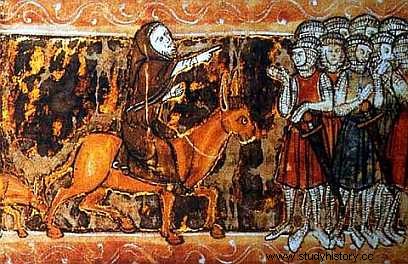
The two types of crusades
The "beggars' crusade"
" God willing ! God willing ! was the rallying cry that marked the start of the Crusades. Urban II had fixed the departure of the great expedition for the month of August 1096. But tens of thousands of people had spontaneously set out before the scheduled date. Without armed protection, they ran to massacre. More than 12,000 people left France in March, led by the fanatic Peter the Hermit, surrounded by charismatic reverence and a nobleman with an evocative name, Gauthier Sans Having. There were:women accompanying their husbands, peasants with ardent faith wishing to flee feudal servitude, children and old people convinced of bringing down the ramparts of Jerusalem by the force of their prayers. There were only eight knights then. At the same time, two other minor groups had departed from Germany. Equipped with very few weapons and meager supplies, a bit like pilgrims going to the neighboring county, this crowd descended the Danube with the intention of reaching Constantinople and, from there, Palestine:almost everyone did not know where was the country. This crusade of the poor turned into a plague. The Crusaders ransacked entire villages for food. Like most of their contemporaries, these pilgrims are not aware of historical time. They think that Christ is barely older than their time, and persist in massacring innocent groups of Jews, qualified as “enemies of Christ”. These plunders and violence provoked the armed reaction of the inhabitants of the regions crossed. A majority reached Constantinople, where Emperor Alexios I led them across the Bosphorus, but advised them to wait for the arrival of the real Crusader army. It was in vain. The crowd continued its march to Nicaea, a Turkish stronghold. There she arranged herself in battle order:a few squads of Turkish archers, coming out of the town, sufficed to decimate these unfortunate dreamers. A squadron of Byzantine ships picked up the few survivors.
Turks massacring pilgrims in 1096
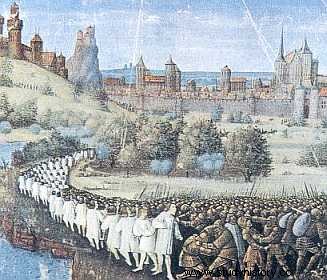
The "Barons' Crusade"
Between the summer and the winter of 1096 the gigantic machine of the first real crusade was set in motion. It was called "the lords' crusade", because no king was associated with it. The various sovereigns of Europe:Philip I, King of France, William II, King of England and Emperor Henry IV had been excommunicated by the Pope. But the leaders of the crusade were brave and quickly acquired great prestige. The expedition includes four armies:
- The French in the North are placed under the command of Hugues de Vermandois, brother of King Philip I of France, and Robert Courteheuse, son of William the Conqueror.
- The Knights of the Rhine and the Meuse are led by two brothers:Baudouin de Boulogne and Godefroi de Bouillon, the most valiant knight of the group, courageous in battle and overflowing with faith.
- A third expedition set out from the South of France under the leadership of the Count of Toulouse, Raymond IV de Saint-Gilles, aged but laden with glory and experience for having already fought the Muslims in Spain.
- Finally, a fourth army set out from southern Italy commanded by the Norman Bohémond de Tarente, the son of Robert Guiscard, who conquered Sicily. Bohémond is an experienced warrior, he has already fought the Muslims. He is accompanied by his nephew, Tancrède de Hauteville, “the incarnation of the ideal of the Christian knight. “The bulk of the Crusader expedition was made up of French contingents or of Frankish stock. So much so that the Muslims who saw a Christian army descending on them, communicating in French, got into the habit of calling all the Christians of Europe "Francs".
The main stages
From Constantinople to Nicaea
The armies, totaling about 30,000 men, which had assembled at various points in Europe, set out, using different routes, to reach Constantinople. The sole command was entrusted to Godfrey of Bouillon, who immediately firmly rejected the proposal of Bohemond of Taranto to seize the Byzantine capital, claiming to have come "only to fight the infidels". But the idea of getting their hands on the rich city of Constantinople remained present. The Byzantine emperor, Alexios I, supplied the Crusader troops, already well exhausted, and undertook to assist them militarily. The crusaders had had trouble with the emperor, who was annoyed that the West took over from the East in the fight against Islam. Alexis thought he saw mercenaries arriving in his pay. He was relieved when the troops finally set out for Jerusalem. Discord ravaged the Crusader army:Godfrey commanded... when he was allowed to. But the still more accentuated division reigning among the Moslems favored the crusaders. The Christian troops occupied Nicaea without great difficulty. Subsequently, they faced the Turks at Dorylée in a very hard battle. Bohemond of Tarentum's troops were surrounded. As usual, the Turks hurled arrows and javelins at their adversaries. But the Franks perfectly mastered the defensive, thanks to their coats of mail and their thick armor. Godfrey's troops then arrived to help. From then on, the Turks abandoned the battlefield, leaving a huge booty, and losing their invincibility.
Crusaders throwing heads from the dead during the siege of Nicaea
In order to sow fear on the besieged, the Franks catapulted skulls over the ramparts of Nicaea.
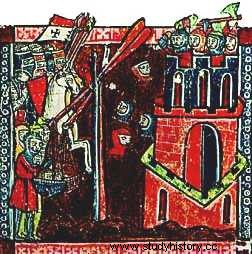
Crusaders catapulting heads of the dead during the siege of Nicaea, by Guillaume de Tyr (miniature in Les Estoires d'Outremer, 13th century, French Ms 2630, folio 22 v., Bibliotheque Nationale, Paris.)
The painful march to Jerusalem
After the victory at Dorylée, the troops had to face their most ruthless enemy:an 800 kilometer march under a blazing sun, in regions devoid of water, while food was scarce and the Bedouin tribes harassed them incessantly. Much more than the battles, these difficulties decimated the expedition. The winter of 1097 was particularly painful:after the sun and the thirst, the crusaders faced the wind and the cold, the rain, the hunger and the epidemics, under the ramparts of Antioch, whose inhabitants resisted eight months. Many Christians deserted and embarked at their own expense on Genoese and Venetian ships to return to Europe. However, many others, the most devout and strong, resisted. Among these survived those who had fed for weeks on "sweet canes called zucra in Arabic”:the Europeans had discovered sugar.
The capture of Antioch
Antioch, besieged by the Crusaders, had resisted for eight months. It was then that the Crusaders learned of the arrival, in reinforcement of the besieged, of a strong Turkish army. This news aroused such a movement of fear and despair that they redoubled their assaults and took Antioch in a week. The city was given over to pillage. The daring Bohemond then led the Crusader troops against the Turkish army, which was defeated. Six months passed during which the crusaders regained their strength and reorganized. But in the meantime, the Crusaders allowed themselves to be intoxicated by power. The lords did not resist the temptation to offer themselves a province, despite the promise made to the Byzantine emperor who was to recover the territories taken from the Turks. Thus, Bohemond had convinced the Byzantines who accompanied him to flee. The Byzantines had abandoned him and he was able to free himself from his oath of vassalage with the emperor. Bohemond thus proclaimed himself Prince of Antioch. As for Baudouin de Boulogne, he attacked Edessa on his own account. Of all the great crusaders, only Raymond IV was not corrupt. He left alone for Jerusalem soon joined by Godefroi de Bouillon.
The Siege of Antioch
One day, a poor pilgrim told his dream where he had seen Saint Andrew who revealed to him the place where the Holy Lance was hidden (the spear of the centurion which would have pierced the side of Christ). The Lance was buried in the ground of the Church of Saint Peter of Antioch. The slabs were raised then a pit was dug, the Holy Lance was found a few days later. Subsequently, Raymond de Saint-Gilles was accused of having imagined the subterfuge of the spear to fanaticize his companions.
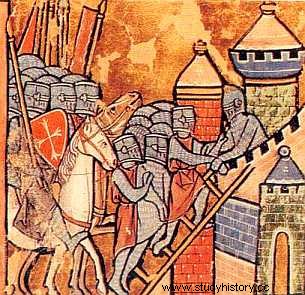
The capture of Jerusalem
On June 7, 1099, three years after their departure from the West, 12,000 soldiers of Christ, ragged, fell to their knees in tears when they saw in the distance the mighty and lofty ramparts of Jerusalem, the Holy City! The Crusaders benefited from the rivalries between Muslims. While the Turks were in Antioch, the Fatimid Egyptians had taken the city of Jerusalem. Godefroi de Bouillon had tents erected around the city and installed siege machines, towers for climbing the ramparts, built by Genoese carpenters, catapults and all the devices designed by military technicians. The garrison of the place, which did not exceed a thousand, observed all these works with astonishment and some fear. The Egyptian caliph sent his ambassadors to the Crusader leaders:he promised, as in the past, complete freedom for Christian pilgrims to stay in the city and visit the holy places. The leaders of the crusade held a council. Were we going to abandon, so close to the goal, the main objective of the expedition and refrain from forming Latin kingdoms in the East, even though some knights had already carved out a few fiefs in the conquered territories? So they demanded an unconditional surrender. The Muslims refused. The siege of the city began. For forty days, the thousand defenders resisted the twelve thousand crusaders who besieged them. On July 15, Godefroi, Tancred and their men succeeded in scaling the ramparts of the city. With axes, they reached the doors, which they opened wide. The soldiers rushed into the city. Exasperated by the privations, exalted by the harangues of the preachers, starving, they thought only of revenge and ransoming the population, as they had done in Antioch. It was an inglorious page of Christianity.
The Looting of Jerusalem
An eyewitness, Raymond d'Agiles, said:"We then saw things never seen before. Many infidels were beheaded, killed by archers or forced to jump from towers. Still others were tortured and then thrown into the flames. Heaps of heads, hands and feet could be seen in the streets. We rode over corpses everywhere. It was such a massacre in the city that ours walked in blood up to their ankles. The Crusaders pillaged ad infinitum:they roamed the streets, entered houses, looted gold, silver, horses, whatever they found...”
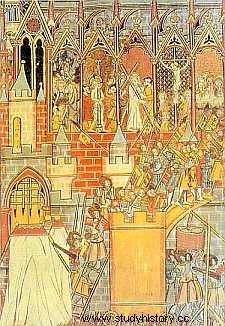
The Crusaders storming Jerusalem in 1099, by Guillaume de Tire (History of Overseas, Municipal Library, Lyon)
The Legacy of the First Crusade
The Latin States of the East
The crusaders finally reached the basilica built on the Holy Sepulcher of Christ, which the infidels had rebuilt after a fanatical ruler had tried to knock it down. There they embraced, crying with joy, the crusaders had finally achieved their goal. Pope Urban II died unaware of the success of the expedition. Godefroi de Bouillon was offered the "Latin" kingdom thus conquered at the expense of Raymond de Saint-Gilles who was the other suitor. He refused the crown, contenting himself with the more modest title of "advocate, or defender of the Holy Sepulchre", not wanting to gird a crown of gold where Christ had a crown of thorns. He defeated an Egyptian army at Ascalon, then actively occupied himself with the organization of his kingdom. He died suddenly, a year after the conquest, possibly poisoned by a Muslim. The kingdom of Jerusalem was therefore entrusted to his brother Baudouin. This first crusade will give birth to four Christian principalities in the Holy Land created on the feudal model of Western Europe. Thus, the 4 Latin States of the East are:
- The County of Edessa, founded by Baudouin
- The principality of Antioch, occupied by Bohemond
- The county of Tripoli, taken in 1109
- The kingdom of Jerusalem, offered to Godfrey of Bouillon
The Latin States of the East
The Frankish States consolidated to appear as a real regional power. France can then develop trade with other Mediterranean ports.
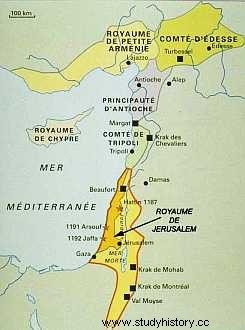
The birth of the orders of chivalry
To defend the Latin States, orders of monk-soldiers were organized into a standing army:thus the Hospitallers, in 1113, and the Templars, in 1118. Fortresses were erected, such as the famous Krak des Chevaliers in Syria. Taking advantage of this new communication with the East, Mediterranean trade intensified and flourished. The Order of the Temple was born in the Holy Land, in 1119, after the first Crusade, on the initiative of the Champagne knight Hugues de Payns who wanted to protect pilgrims going to Jerusalem. It was made official by the Council of Troyes, nine years later at the request of Bernard de Clairvaux. The order takes its name from Solomon's temple in Jerusalem, where it had its headquarters in its early days. The order gained influence over the centuries and recruited throughout Europe. He will defend the Latin powers in the East, isolated from the Western forces.
The Da Vinci Code Phenomenon
The plot of the best-selling "Da Vinci Code" is based on the often disputed secrets of the Priory of Sion. The novel explains that the Priory of Sion would be a secret society founded in 1099, after the first crusade, by Godfrey of Bouillon. Having discovered a grave secret concerning his family, concealed since the time of Christ, he commissioned the secret society to watch over this secret and pass it on to subsequent generations. According to legend Godefroi would be an heir of the Merovingians. By this very fact, Godfrey would be a descendant of Christ and of Mary Magdalene who came to take refuge in Gaul. For many, information about Christ's lineage is the Holy Grail, usually depicted in the form of the chalice (sacred vessel), immortalized in the tales of Chretien de Troyes. The Priory is strongly linked to the Order of the Temple, Hugues de Payns, the founder of the Templars would also be the first grand master of the Priory of Sion. The Priory would still exist, and the mystery that surrounds it raises many questions. Of course, all theses of Brown are to be taken with hindsight, because it is about a novel. Concerning the Priory, its creation dates back only to the 1950s. this is Saint John.)
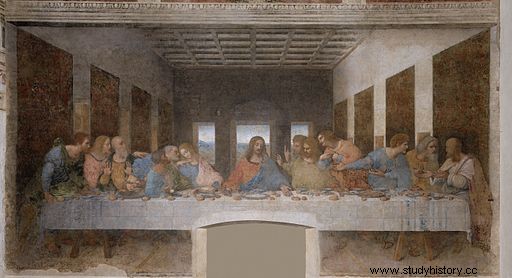
The Last Supper, by Leonardo da Vinci
European Orders of Knighthood
- The Order of the Holy Sepulcher of Jerusalem (1099)
- The Hospitaller Order of Saint John of Jerusalem, or, Sovereign Order of Malta (1113)
- The Order of the Temple (1118)
- The Order of Calatrava (1158)
- The Order of Saint James of the Sword (1170)
- The Order of Alcántara (1177)
- The Order of Saint Benedict of Aviz, or, of Avis (1187)
- The Constantinian Order of Saint George (1190)
- The Teutonic Order (1198)
- The Order of Saint Lazarus of Jerusalem, and, Our Lady of Mount Carmel (before 1200)
- The Order of Swordbearing Knights (1202)
- The Order of Saint Mary of Spain (1272)
- The Order of Montesa (1317)
- The Order of Christ of Portugal (1319)
- The Most Noble Order of the Garter (1348)
- The Order of the Knights of the Noble House of Saint-Ouen, or, Knights of the Star (1351)
- The Most Honorable Order of the Bath (1399)
- The Noble Order of the Golden Fleece (1430)
- The Order of the Elephant (1462)
- The Order of Saint Michael (1469)
- The Order of San Stefano (1561)
- The Order of Saints Maurice and Lazarus of Savoy (1572)
- The Order of the Holy Spirit (1578)
- The Bailliage of Utrecht of the Teutonic Order (1580)
- The Most Ancient and Most Noble Order of the Thistle (1687)
- The Royal and Military Order of Saint-Louis (1693)
- The Legion of Honor (1802)
Source and descriptions: http://lorl.free.fr/ordlist.htm
